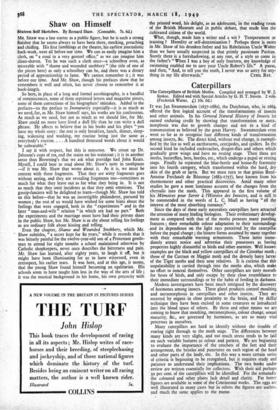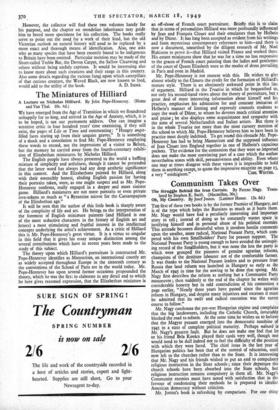Caterpillars
IT was Jan Swammerdam (1637-1680), the Dutchman, who, in 1669, offered the first logical account of the transformations of insects and other animals. In his General Natural History of Insects he earned enduring credit by showing that transformation or meta- morphosis was due to growth changes and not to a kind of transmutation as believed by the great Harvey. Swammerdam even went so far as to recognise four different kinds of transformation among insects, &c. The direct kind, without real change, is exempli- fied by the lice as well as earthworms, centipedes, and spiders. In the second kind he included cockroaches, dragon-flies and others which gradually grow wings and have no resting stage. Then there are moths, butterflies, bees, beetles, etc., which undergo a pupal or resting stage. Finally he separated the blue-bottle and house-fly fraternity into his fourth category, which transformed within the hard, dry skin of the grub or larva. But we must turn to that genius Rene- Antoine Ferchault de Reaumur (1683-1757), best known from his thermometer and other practical discoveries. Amid many other studies he gave a most luminous account of the changes from the chrysalis into the moth. This appeared in the first volume of his Memoires pour Servir a l'Histoire des Insectes, and is still to be commended in the words of L. C. Miall as having " all the interest of the most absorbing romance."
Since the days of these early naturalists caterpillars have attracted the attention of many leading biologists. Their evolutionary develop- ment as compared with that of the moths presents many puzzling features ; their remarkable colour adaptation to their surroundings and its dependence on the light rays perceived by the caterpillar before the pupal change ; the bizarre forms assumed by many together with their remarkable warning armaments. These latter imme- diately attract notice and advertise their possessors as having properties highly distasteful to birds and other enemies. Well known examples are the black and yellow caterpillars of the Cinnabar moth ; those of the Currant or Magpie moth and the densely hairy larvae of the Tiger moths and their near relatives. It is curious that this unpalatability is carried through into the moths also, which make no effort to conceal themselves. Other caterpillars are tasty morsels for hosts of birds, and only escape by their close resemblance to their immediate surroundings or by the habit of feeding in darkness.
Modern investigators have been much intrigued by the discovery of hormones among insects. These gland products control moulting and metamorphosis in caterpillars and other insects. They are secreted by organs in close proximity to the brain, and by skilful technique they have been excised in some creatures or introduced into the blood space of others. By these and other means we are corning to know that moulting, metamorphosis, colour change, sexual maturity, &c., are governed by hormones, as are so many vital processes in ourselves.
Many caterpillars are hard to identify without the trouble of rearing right through to the moth stage. The differences between many kinds are very slight, and too much stress tends to be laid on such variable features as colour and pattern. We are beginning to evaluate the importance of the crochets of the feet and their arrangement, the bristles and punctures on each region of the head and other parts of the body,,etc. In this way a more certain series of criteria is beginning to be recognised, but it requires study and patience to understand their implications. The two books under review are written essentially for collectors. With their aid perhaps 5o per cent. of the caterpillars will be identified. For the remainder the coloured and other plates lack detail and clarity. Far better figures are available in some of the Continental works. The eggs are well illustrated in many cases but in others the figures are useless, and much the same applies to the pupae. However, the collector will find these two volumes handy for his purpose, and the chapter on mendelian inheritance may guide him to breed more specimens for his collection. The books really serve to point out the need for a work of their kind, but the old Victorian outlook on natural history will need to be replaced by a more exact and thorough means of identification. Also, one asks why so many species that have been recently found to be indigenous to Britain have been omitted. Particular mention may be made of the Short-tailed Treble Bar, the Devon Carpet, the Sallow Clearwing and others without being unduly captious. It would be interesting also to know more about such creatures and their range in this country. Also some details regarding the various fungi upon which caterpillars of that curious creature, the Waved Black, are now known to feed,
would add to the utility of the book. A. D. Inv's.







































 Previous page
Previous page